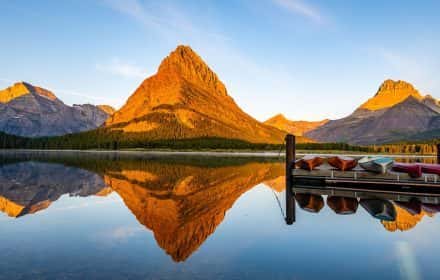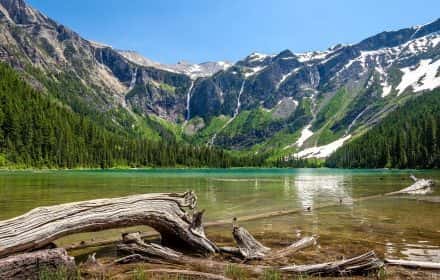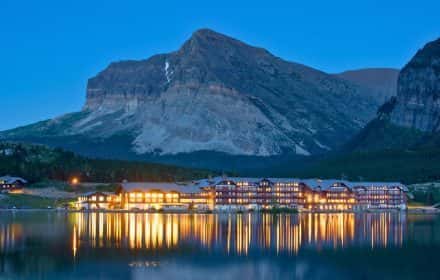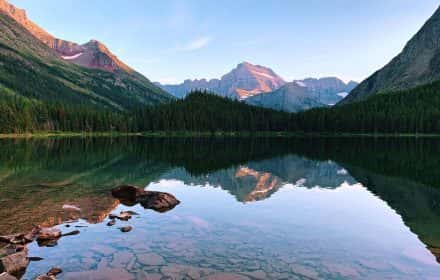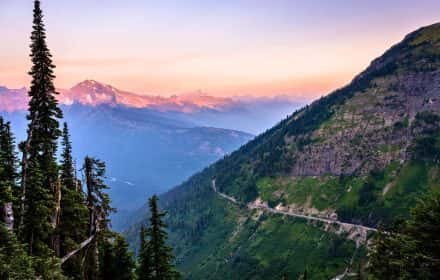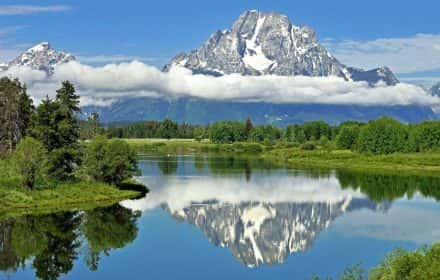This site uses affiliate links, meaning that if you make a purchase through our links, we may earn an affiliate commission.
We have 9 essential tips for your first visit to Glacier National Park to ensure your experience is truly extraordinary. Get ready to explore the Rockies with our insider insights, turning your first time at Glacier National Park into an unforgettable adventure!
- 1. 9 Tips for First Visit to Glacier National Park
-
- 1.1. Smart Tips for Getting to Glacier
- 1.2. Optimize Your Visit by Choosing the Perfect Time
- 1.3. Smart Tips for Navigating in Glacier National Park
- 1.4. Explore Your Options for Accommodations (Inside or Near the Park)
- 1.5. Discover Glacier National Park's Regions - Find the Best Fit for You!
- 1.6. Dive into Interesting Facts About Glacier National Park
- 1.7. Conquer the Going-to-the-Sun Road (Bucket List Experience)
- 1.8. Embark on Hiking Trails in Glacier National Park
- 1.9. Discover Prime Photography Spots in Glacier National Park
- 2. Intrepid Scout's Tips for Glacier National Park
9 Tips for First Visit to Glacier National Park
Smart Tips for Getting to Glacier
- Location of Glacier National Park
Glacier National Park is located in the northern Rocky Mountains in northwestern Montana on the border with Canada’s Waterton Lakes National Park. These two parks form Waterton-Glacier International Peace Park, dedicated in 1932.
Glacier and Waterton Lakes are called the “Crown of the Continent”. They sit on the Continental Divide, the great ridge of the Rocky Mountains, which marks the boundary between the westward headwaters of streams that flow into the Pacific Ocean and the eastward that flow into Hudson Bay and the Gulf of Mexico.
- Getting to Glacier:
By Air: Glacier Park International Airport (FCA) in Kalispell, Montana is the nearest major airport to Glacier National Park. Kalispell is located about 12 miles from the town of Whitefish and 30 miles from the West entrance to Glacier National Park.
Great Falls International Airport (GTF) in Great Falls, Montana is another airport that you can fly in. It is located 180 miles from the entrance to the park.
Another airport that you might want to check out is Missoula Montana Airport (MSO) in Missoula about 138 miles from the West entrance to the park.
I use Skyscanner to browse flights and find the best prices.
By Car: If you prefer driving, Glacier National Park can be accessed via several entrances. The West Glacier entrance is the most popular and provides direct access to the park’s main visitor center. Other entrances include St. Mary, Many Glacier, and Two Medicine. Check for any road closures or construction updates before your trip here.
By Train: Amtrak’s Empire Builder route runs through the southern part of the park, with stations in East Glacier and West Glacier. This scenic train journey offers breathtaking views and is a unique way to reach the park.
By Bus: Various tour companies and shuttle services operate in and around Glacier National Park. They offer transportation from nearby towns and cities, such as Kalispell and Whitefish, to different areas within the park. It’s a convenient option if you prefer not to drive.
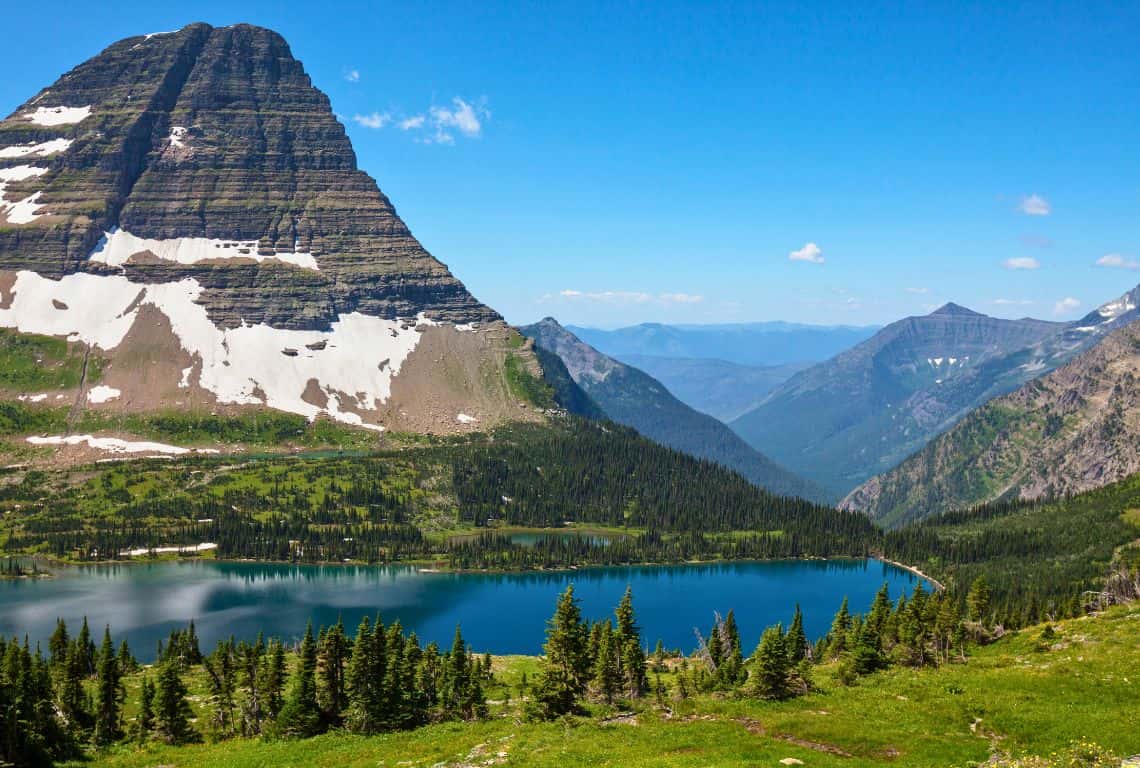
Hidden Lake / Tips for First Visit to Glacier National Park
Optimize Your Visit by Choosing the Perfect Time
When planning your visit to Glacier National Park, timing is crucial to make the most of your experience.
Here are some tips to help you determine the best time to go:
- Visiting During the Shoulder Seasons
May-June or September are my favorite times for visiting Glacier National Park. While the park is open from late May to late September, the peak season is from July to August when the park is bustling with visitors.
By opting for the shoulder seasons, you can enjoy several advantages. You encounter fewer crowds, allowing you to have a more serene and immersive experience amidst nature’s beauty.
Additionally, popular hiking trails and attractions are generally less crowded during this time, giving you the opportunity to fully appreciate the park’s tranquility.
Moreover, the weather in Glacier National Park can be unpredictable, even during the summer months. By visiting during the shoulder seasons, you can avoid the peak of summer heat and potential afternoon thunderstorms. The cooler temperatures and pleasant weather during these times provide a comfortable environment for outdoor activities.
Lastly, wildlife sightings are often more abundant during the shoulder seasons. The spring months of May and June bring newborn animals, while the fall months of September offer opportunities to witness elk and deer during their rutting season.
- Wildflower Blooms in June
If you’re a fan of colorful wildflowers, consider planning your visit to Glacier National Park in June. This is when the alpine meadows burst into vibrant displays of wildflowers, creating a picturesque landscape. Lupines, Indian paintbrush, and glacier lilies are just a few of the many wildflower species you can expect to see.
Exploring the park during this time offers a unique opportunity to witness the beauty of nature in full bloom.
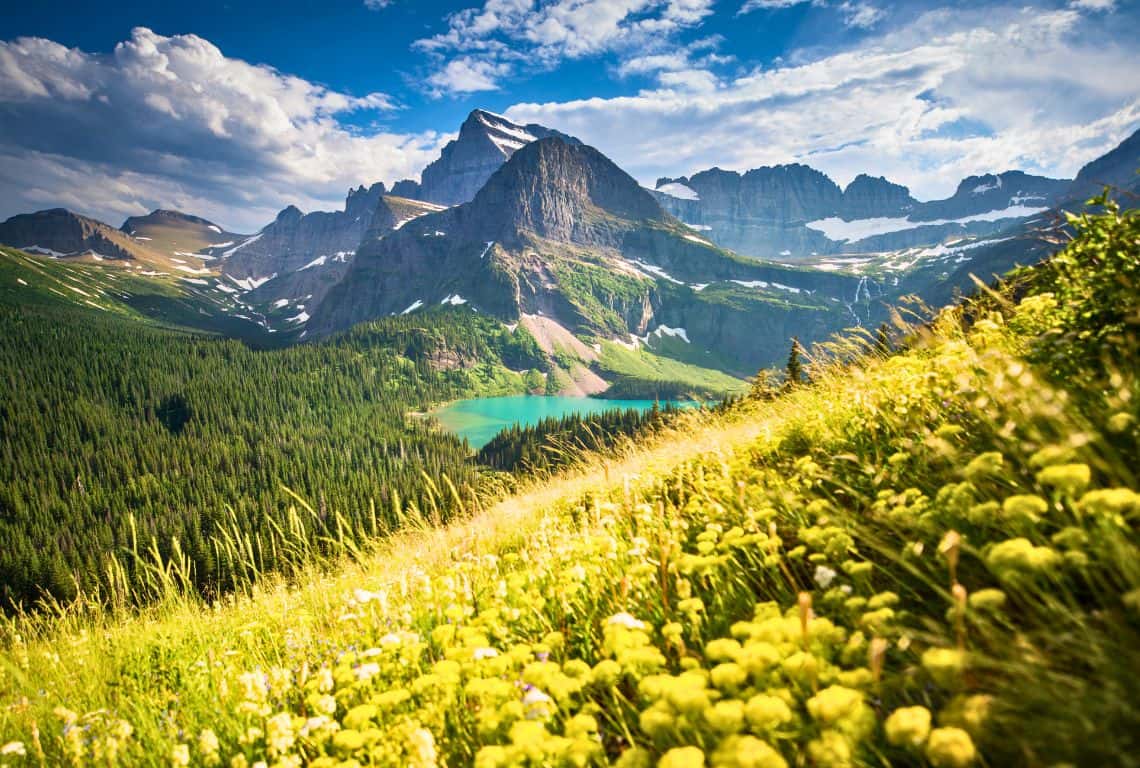
Grinnell Lake and Wildflowers / First Visit to Glacier National Park
- August and September for Fall Colors
For those who appreciate the stunning hues of autumn, late August through September is an ideal time to visit Glacier National Park.
During this period, the park’s dense forests and alpine slopes transform into a breathtaking palette of reds, yellows, and oranges as the foliage changes colors.
The fall colors create a picturesque backdrop for hiking, scenic drives, and photography, adding an extra layer of beauty to your visit.

Two Medicine Lake at Sunrise / First Visit to Glacier National Park
- July and August for Accessibility and Activities
If accessibility and a wide range of activities are your priority, consider visiting Glacier National Park in July and August.
During these summer months, all areas of the park are typically open, including the full length of the Going-to-the-Sun Road.
The warmer weather allows for various outdoor activities like hiking, camping, boating, and wildlife watching.
Additionally, the visitor centers and park facilities operate at full capacity, providing ample resources and information for visitors.
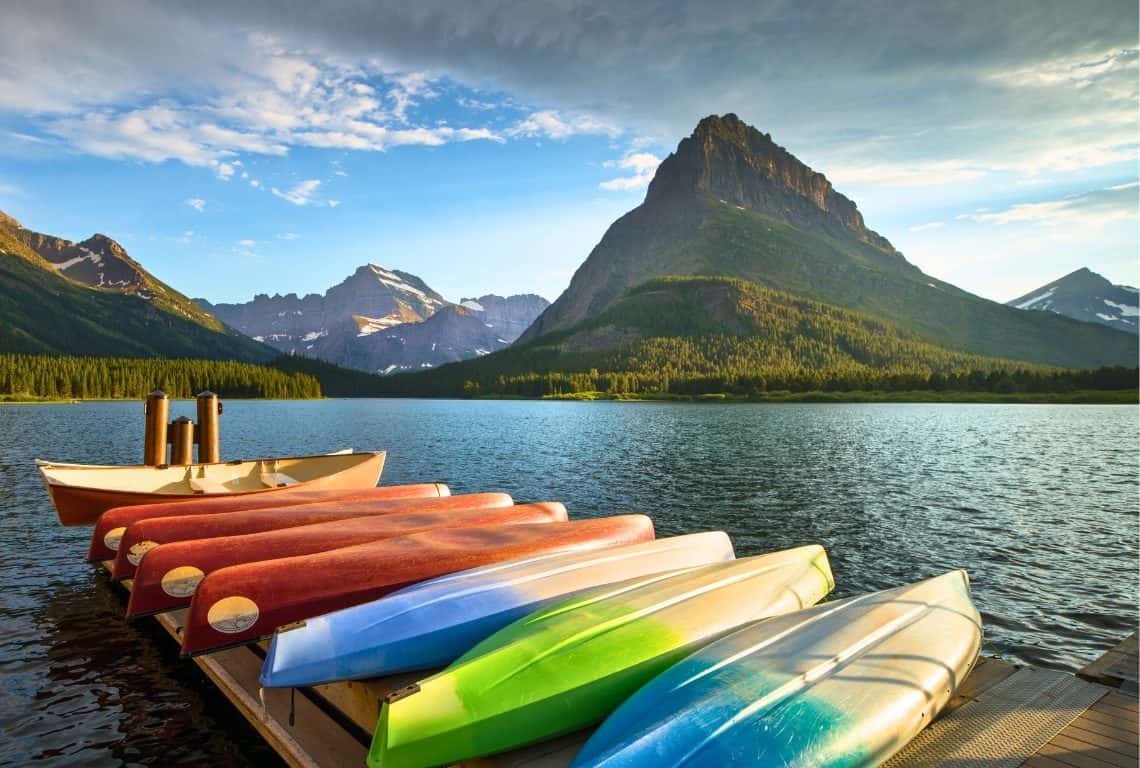
Canoes at Swiftcurrent Lake / First Visit to Glacier National Park
GOOD TO KNOW: Keep in mind that weather conditions and peak times may vary from year to year, so it’s always recommended to check the park’s website or contact the visitor center for the most up-to-date information on seasonal highlights and conditions.
By considering the timing of wildflower blooms, fall colors, and the accessibility and activities available during different months, you can choose the best time to visit Glacier National Park based on your specific interests and preferences.
Smart Tips for Navigating in Glacier National Park
Getting around Glacier National Park is an important aspect of maximizing your visit. Here are some tips on how to navigate the park effectively:
- Private Vehicle:
Driving your car or renting a car is the best option to get around Glacier National Park whether this is your first visit to Glacier or you are a returning visitor. This option is the most convenient and gives you the most flexibility, and since, some areas of Glacier are so remote, it is sometimes the only way to get around.
PRO TIP: If you are visiting during the summer months, finding a parking spot can be very challenging. My recommendation is to start your day early and have a lot of patience while waiting for a spot to open.
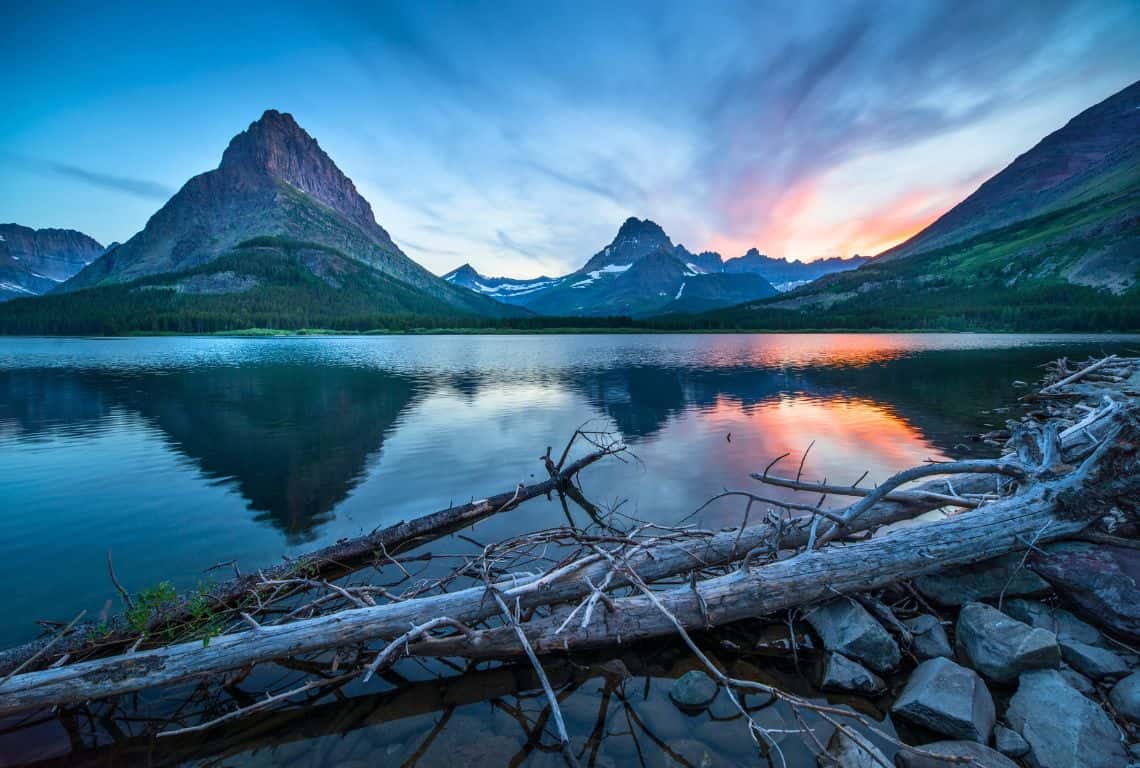
Swiftcurrent Lake at Sunrise / First Visit to Glacier National Park
- West and East Shuttle Service:
Glacier National Park offers West and East Shuttle Service that operates on the Going-to-the-Sun Road.
West and East Shuttle Services are free (cost included in your entrance pass). You can hop on/hop off at any of the shuttle stops. The shuttle operates on a first-come, first-serve basis. Shuttles are wheelchair accessible and some have bike racks.
Going-to-the-Sun Shuttle Service usually operates from July 1st through Labor Day (weather permitting).
West Shuttle runs from Apgar Visitor Center to Logan Pass and has 5 stops along the way. It operates 7 days a week from 7 am till 7 pm.
East Shuttle runs from St. Mary Visitor Center to Logan Pass and makes 8 stops along the way. It operates 7 days a week from 8 am till 7 pm.
GOOD TO KNOW: To traverse the entire Going-to-the-Sun Road using the shuttle system, you will need to make four transfers along the way starting at Apgar, then Avalanche Creek, Logan Pass, and Sun Point.
Shuttles that run from Apgar Visitor Center and Avalanche Creek and Sun Point and St. Mary Visitor Center have a 28-passenger capacity and run approximately every 30-40 minutes.
Shuttles operating between Avalanche Creek and Logan Pass and, then from Logan Pass and Sun Point are small and can only take 12-15 passengers. They run approximately every 15-20 minutes.
PRO TIP: From my personal experience, the shuttle system is not very efficient. If you have to use it, then be prepared to wait until there is an open seat.
- Tour Companies:
There are tour companies that operate in Glacier National Park.
Going on a tour might be a great option if this is your first visit to the park.
Sun Tours offers interpretive tours, on air-conditioned 25-passenger window coaches, highlighting Blackfeet culture. Daily service is offered from West Glacier, East Glacier, St. Mary, and Browning during the peak season.
Xanterra Parks & Resorts offers tours in their signature Red Jammers – classic open-air shuttles. They have routes that run through the Going-to-the-Sun Road, the Many Glacier Valley Region, and the Two Medicine Valley Region.
GOOD TO KNOW: There are some pluses and minuses with going on a tour. However, going on a tour is convenient, since you do not have to drive yourself and you can just sit and relax and enjoy the scenery.
Explore Your Options for Accommodations (Inside or Near the Park)
Finding suitable accommodations is crucial for a comfortable and convenient stay in or near Glacier National Park.
Whether you prefer staying within the park or in nearby towns, choosing the right location can optimize your access to hiking trails, scenic viewpoints, and other attractions.
Here, we provide recommendations for accommodations in different areas, ensuring you find the perfect place to rest and rejuvenate after your outdoor adventures in Glacier National Park.
I compiled a short and handy list of the 14 best places to stay in or around Glacier National Park whether you are visiting the west or east side (or both) of this amazing national park. Check it out!
Recommendations by Area:
- West Glacier:
Inside the Park: Lake McDonald Lodge offers a historic lodge experience with lakeside views.
Near the Park: If you are looking for an elegant place, then Belton Chalet is the perfect place. Belton Chalet is a charming Swiss Chalet-style hotel situated at the West Entrance to Glacier National Park. Great Northern Resort is located right at the Western Entrance to Glacier National Park. It has log cabins, which are great, as well as a newly built lodge. What I like about it is that it can accommodate large groups.
- East Glacier:
Inside the Park: Many Glacier Hotel provides a classic alpine lodge experience near stunning hiking trails and the iconic Many Glacier areas.
Near the Park: Glacier Park Lodge is located in East Glacier Park Village, just 15 minutes from Two Medicine Entrance to Glacier National Park. Mountain Pine Motel is located in East Glacier Park Village. It is a great place to stay if you are exploring the Two Medicine Valley Region of Glacier National Park.
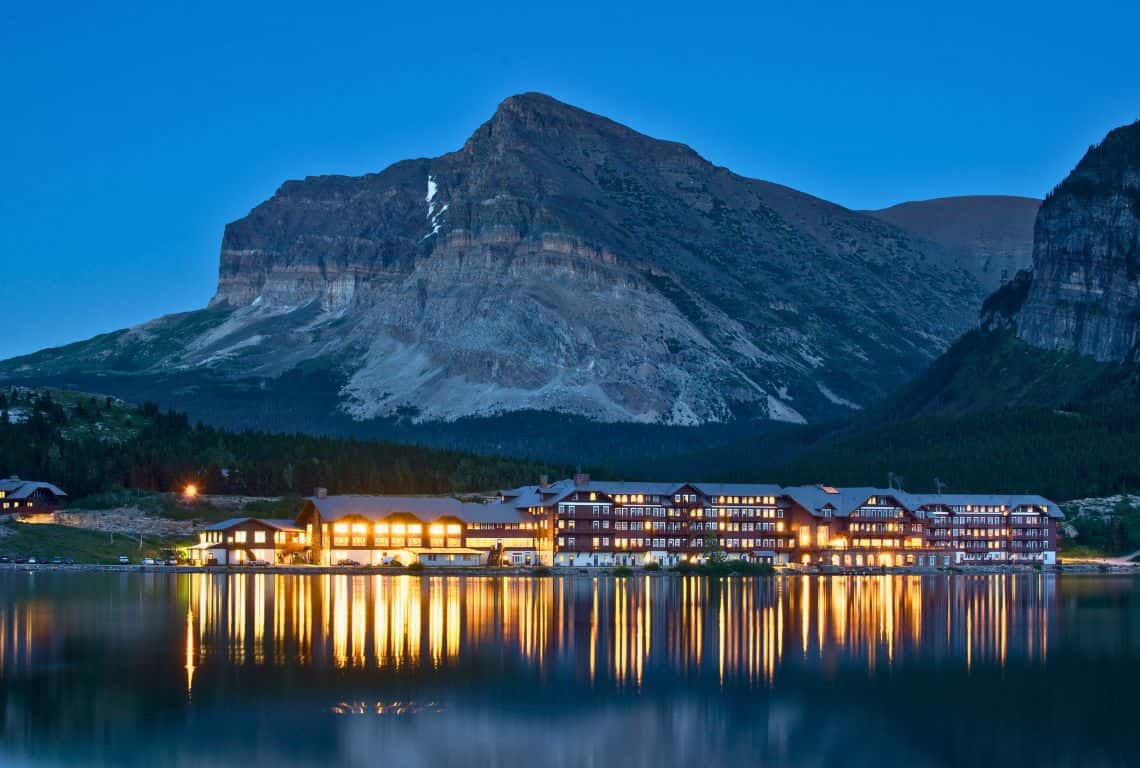
Many Glacier Hotel / First Visit to Glacier National Park
Discover Glacier National Park's Regions - Find the Best Fit for You!
Glacier National Park is divided into different regions, each offering unique landscapes and attractions. When planning your visit to Glacier National Park, consider exploring multiple regions to experience the diverse beauty the park has to offer.
By venturing into different areas of the park, you will gain a deeper appreciation for its natural wonders and create a well-rounded adventure.
Here’s an overview of the main regions in Glacier National Park:
- Lake McDonald Valley Region
Lake McDonald Valley Region is situated on the western side of Glacier National Park. It is, no doubt, the most popular as well as the most crowded region of the park.
The closest airport to Glacier National Park is located on the west side of the park in the town of Kalispell, which is 30 miles from the West Entrance making it very convenient to stay on the west side.
West side has more places to stay to choose from ranging from budget to luxury. Plus, staying on the west side is less expensive!
There are plenty of dining options to choose from on the west side of the park. Also, as far as convenience stores, grocery stores, and gas stations, you will have lots of options.
Beautiful Lake McDonald is situated right by the Western Entrance. If you like water activities, then this is the place for you! You can rent kayaks and paddle boards, also, fishing is pretty good here (my daughter swears by it!). Also, there are lots of picnic areas to take a break or hang out in for a day.
GOOD TO KNOW: Some of the best easy family-friendly hikes are located on the west side: Johns Lake Loop Trail and Trail of the Cedars are some of my favorites!
PRO TIP: The historic Lake McDonald Lodge is situated right by Lake McDonald and it is worth checking out.
- Logan Pass and St. Mary Valley Region
Logan Pass and St. Mary Region are situated east of Lake McDonald Valley Region.
Logan Pass is the highest elevation (6,646 feet) reachable by car in the park located on the Going-to-the-Sun Road.
St. Mary Valley Region is located on the eastern side of Glacier National Park. Some of the best trails in Glacier National Park start in St. Mary Valley Region.
There are not many dining places, accommodations options, grocery stores, gas stations, etc on the east side of the park. Also, accommodations tend to be more expensive in this section of the park.
PRO TIP: If you are looking to escape the crowds and find some solitude then the east section of the park might be a better option for you than staying on the west side.
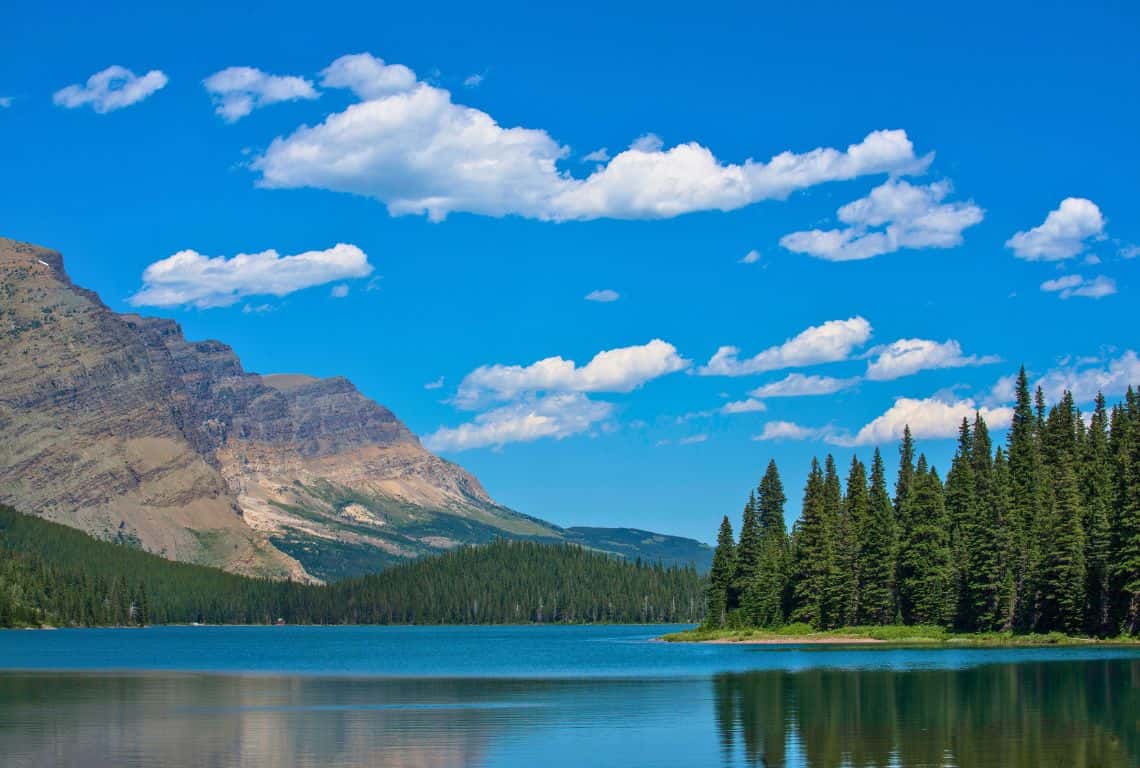
Lake Josephine / First Visit to Glacier National Park
- Two Medicine Valley Region
Two Medicine Valley Region is also situated on the eastern side of the park. Specifically, it is located in the southeast section of Glacier National Park.
To reach the Two Medicine Valley Region, you will have to exit the park, then drive south on Highway 89 for about an hour, and re-enter the park.
Some of the most challenging trails are located in the Two Medicine Valley Region. Two Medicine Lake is one of the most spectacular sunset locations in Glacier!
East Glacier Village, located no more than 15 minutes from Two Medicine Entrance, offers several excellent accommodations that are perfect if you are exploring this section of the park.
- Many Glacier Valley Region
This is my favorite region of the park to stay and explore. Many Glacier Valley Region is located in the northeastern section of the park. To reach it, you will have to exit the park, then drive north on Highway 89 for about 15 minutes, and re-enter the park.
My favorite place to stay in Glacier National Park, the historic Many Glacier Hotel, is located in this section of the park.
GOOD TO KNOW: What I like about the Many Glacier Valley Region of the park is the hiking trails. Hands down, you will find the most scenic hikes right in this area.
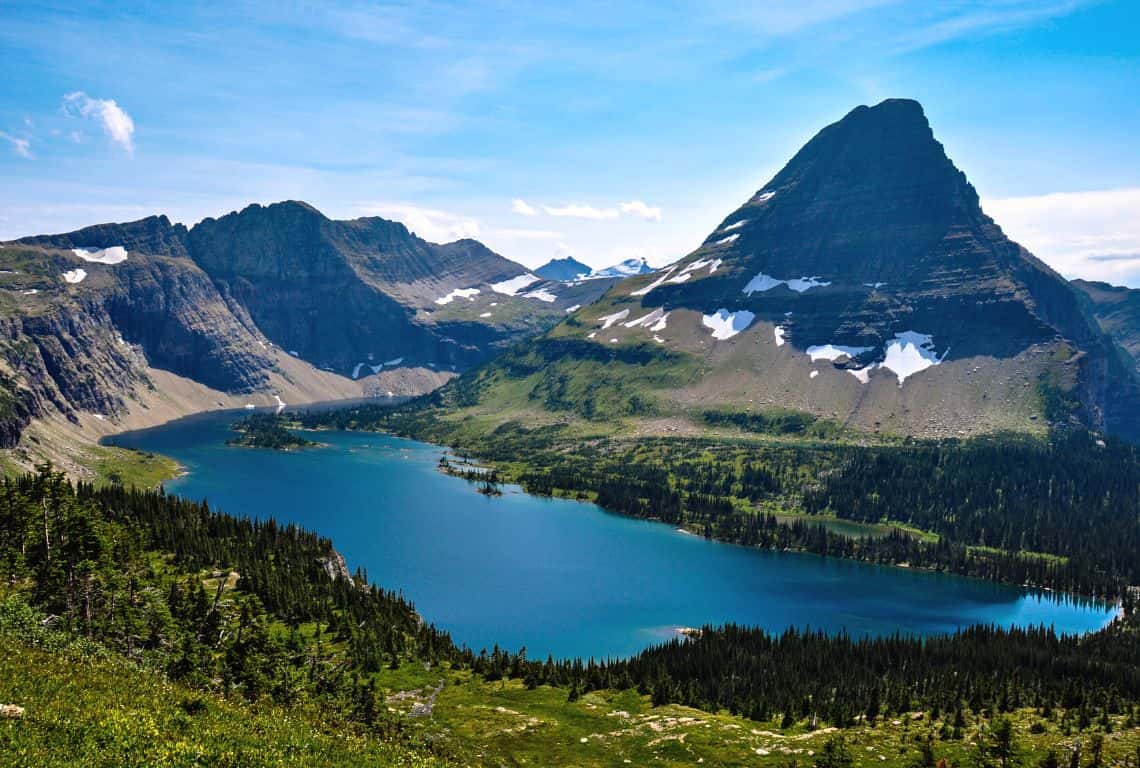
Hidden Lake in St. Mary Valley Region / First Visit to Glacier National Park
- North Fork and Goat Haunt Region
North Fork and Goat Haunt Region is located in the northwestern section of the park.
North Fork is only accessible by unpaved road and Goat Haunt requires backcountry hiking access.
These two areas are still on my list of places to explore!
Dive into Interesting Facts About Glacier National Park
Exploring Glacier National Park is not just about stunning landscapes and thrilling adventures. It’s also an opportunity to dive into the captivating history, geology, and wildlife of this remarkable place.
Here are some fascinating facts about Glacier National Park:
- Glacier National Park became the United States’ 8th National Park in 1910. It preserves 1 million acres of land with 792 lakes and 2,800 streams.
- Glacial Origins: Glacier National Park gets its name from the ancient glaciers that once covered the area. While the glaciers have significantly receded, showcasing the ongoing forces of nature there are still 26 active glaciers (Blackfoot Glacier is the largest at 370 acres), showcasing the ongoing forces of nature
- Geological Marvel: The park features stunning geological features, including the famous Going-to-the-Sun Road. This engineering marvel spans 50 miles and traverses the Continental Divide, offering breathtaking views of mountains, valleys, and glacially carved landscapes.
- International Peace Park: Glacier National Park is part of the world’s first International Peace Park. It joins together with Waterton Lakes National Park in Canada to create the Waterton-Glacier International Peace Park, promoting cooperation and conservation between the two countries.
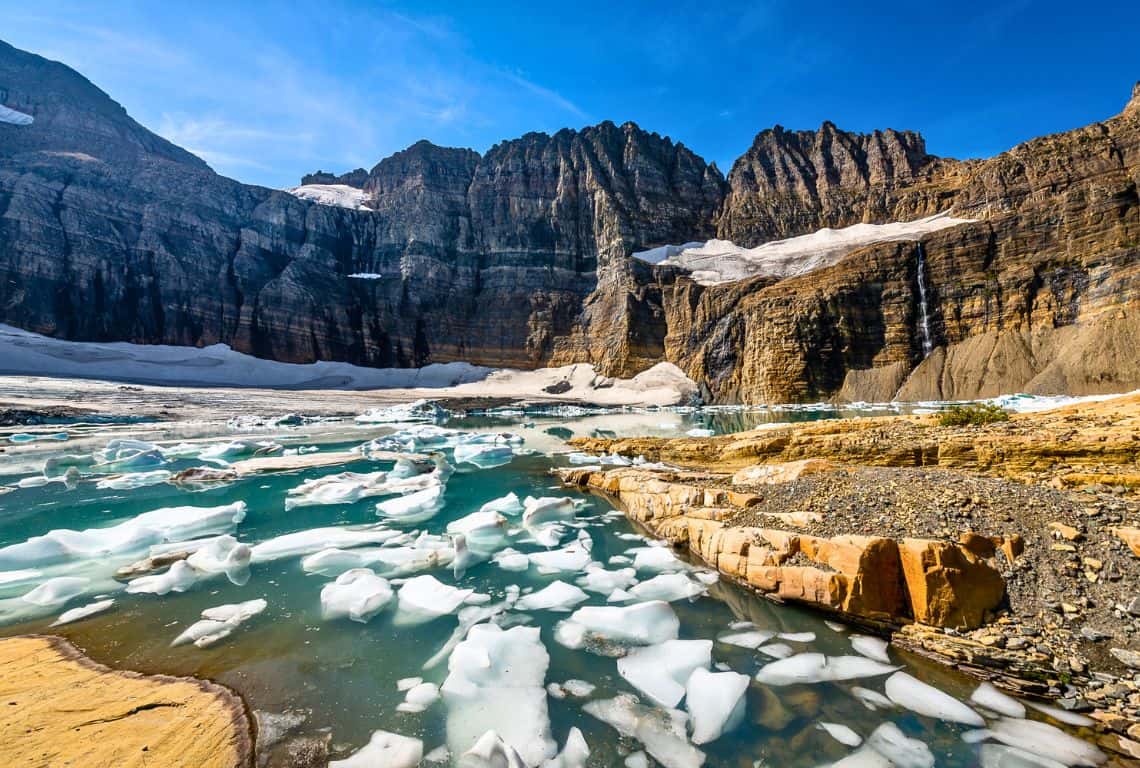
Grinnell Lake / First Visit to Glacier National Park
- Biodiversity Hotspot: The park is a haven for wildlife, with over 70 species of mammals and more than 270 species of birds. Keep an eye out for grizzly bears, mountain goats, bighorn sheep, moose, and the elusive wolverine as you explore the park’s trails and valleys.
- Dark Sky Preserve: Glacier National Park is recognized as an International Dark Sky Park, making it an exceptional destination for stargazing. On clear nights, visitors can witness the awe-inspiring sight of a pristine night sky, with countless stars twinkling overhead.
- Historic Lodges: The park is home to several historic lodges, such as the Many Glacier Hotel and Lake McDonald Lodge. These lodges offer a glimpse into the past, preserving the park’s rich history and providing unique accommodations for visitors.
- Transboundary Ecosystem: Glacier National Park is part of the Crown of the Continent Ecosystem, a vast and interconnected landscape that spans three U.S. states and two Canadian provinces. This transboundary ecosystem plays a crucial role in maintaining biodiversity and wildlife migration patterns.
- Glacier National Park is the 10th most visited National Park in the US with 3 million visitors annually.
- Glacier National Park is a hiker’s paradise! There are over 740 miles of hiking trails and over 50 day-hikes that lead to the most spectacular places.
Conquer the Going-to-the-Sun Road (Bucket List Experience)
Embarking on a journey along the Going-to-the-Sun Road in Glacier National Park is an unforgettable experience!
The 51-mile scenic Going-to-the-Sun Road in Glacier National Park is one of the best ways to experience the beauty of the park. There are numerous viewpoints, scenic short hikes, and overlooks along the Going-to-the-Sun Road that offer unsurpassed views of the park.
The road crosses the Continental Divide through Logan Pass at an elevation of 6,646 feet, which is the highest point on the road.
GOOD TO KNOW: What you need to know is that you are required to have a reservation ticket to access the Going-to-the-Sun Road. Reserve your ticket HERE
You can drive on the Going-to-the-Sun Road after 3 pm without a reservation ticket. So, all in all, if you are not able to get a reservation ticket, then make the drive after 3 pm. You will still be able to enjoy the views, do a couple of short hikes, and catch a breathtaking sunset.
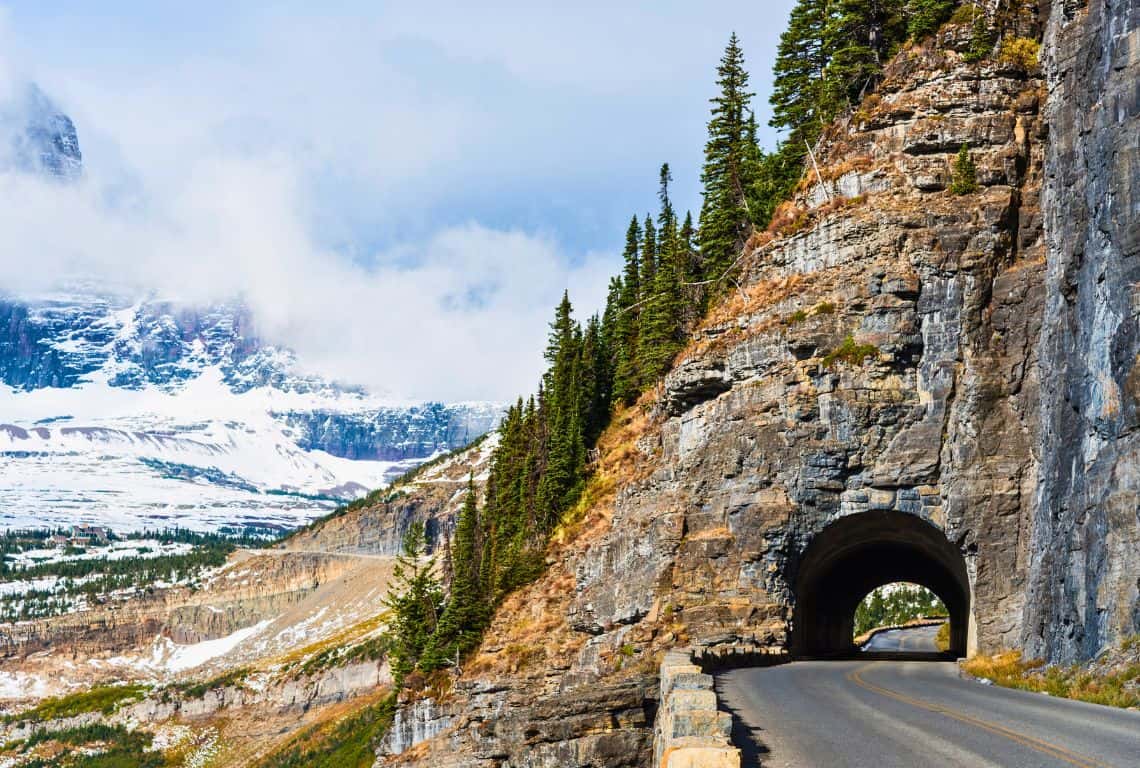
Going-to-the-Sun Road / First Visit to Glacier National Park
PRO TIP: You can reserve the pass to drive the Going-to-the-Sun Road at Recreation.gov. The pass costs $2.00. The reservation pass and the park pass are required to enter the Going-to-the-Sun Road.
Visitors with service reservations along the Going-to-the-Sun Road corridor do not need a vehicle reservation. If you have camping or lodging reservations, commercial tours, and horseback riding reservations along the Going-to-the-Sun Road, you do need a reservation pass to drive the road. For a complete list of service reservations, check here.
Reservations become available 120 days before the day you want to get a reservation and the day before at 8 am MDT.
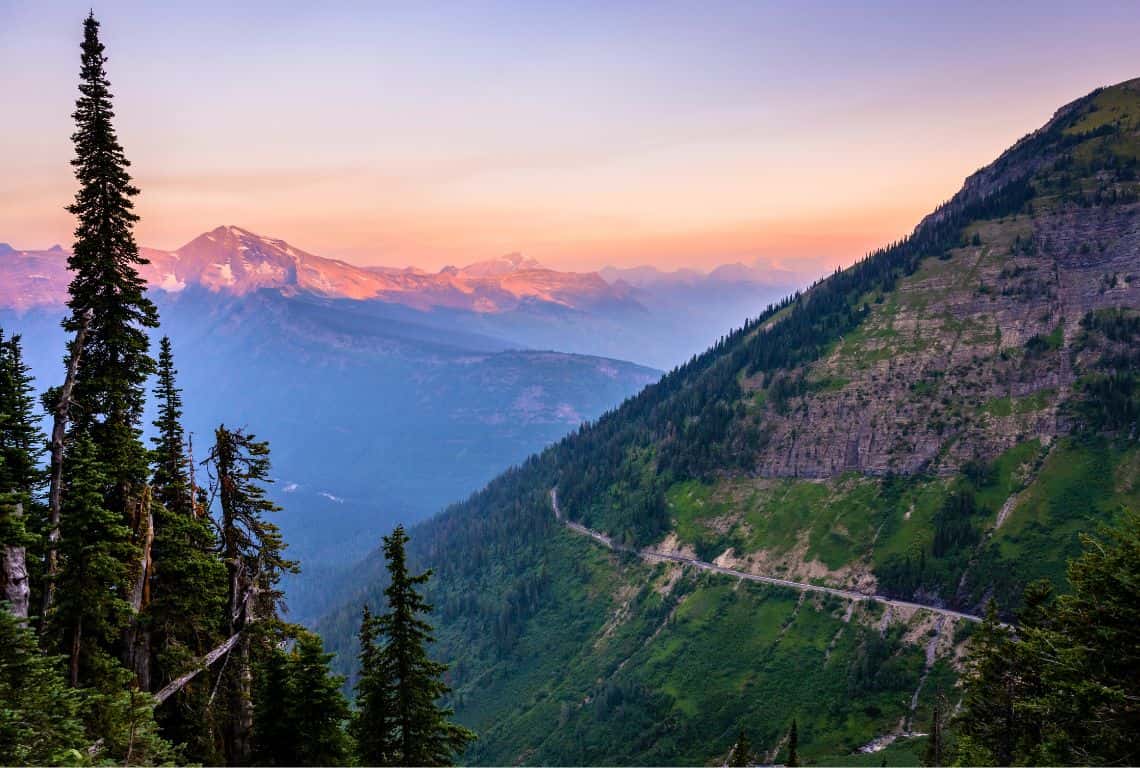
Going-to-the-Sun Road / First Visit to Glacier National Park
To make the most of this iconic road trip, here are essential tips to ensure a smooth and enjoyable adventure:
- The Going-to-the-Sun Road can be busy during peak season, so plan your drive accordingly. Consider starting early in the morning or later in the afternoon to avoid the heaviest traffic. This will not only provide you with a more relaxed journey but also increase your chances of finding parking at popular viewpoints and trailheads along the road.
- Before setting out on the Going-to-the-Sun Road, check for any road closures, construction, or weather-related restrictions. The road is subject to closures due to snowfall, so it’s essential to stay informed and plan your visit accordingly. The park’s official website or visitor centers can provide up-to-date information on road conditions.
- To minimize traffic congestion and parking challenges, take advantage of the park’s shuttle services on the Going-to-the-Sun Road. The shuttle allows you to relax and enjoy the scenery while minimizing the stress of finding parking at popular stops. Hop on and off at various points along the route, exploring different areas of the park at your leisure.
- The Going-to-the-Sun Road is dotted with numerous viewpoints that offer awe-inspiring vistas of glaciers, valleys, and mountain peaks. Don’t rush through the drive. Take your time to stop at the designated viewpoints, stretch your legs, and soak in the majestic scenery. Be sure to bring your camera to capture the breathtaking moments.
- Glacier National Park is home to a variety of wildlife, including bears, elk, and mountain goats. While driving, be cautious and watch for any wildlife near or crossing the road. Maintain a safe distance and never approach or feed the animals. Admire them from a respectful distance and help preserve their natural behaviors.
Embark on Hiking Trails in Glacier National Park
Hiking in Glacier National Park is an incredible way to immerse yourself in the park’s untamed beauty, encounter wildlife, and witness breathtaking landscapes up close.
With over 740 miles of trails, ranging from easy strolls to challenging treks, Glacier National Park offers hiking opportunities for all skill levels.
GOOD TO KNOW: To simplify the process, I compiled a list of 8 fun and easy hikes that are perfect for every fitness level. So make sure to check them all out!
PRO TIP: If you like longer and more challenging hikes, then I came up with a list of the 9 most scenic hikes that will take you to the most stunning places and test your endurance along the way.
To ensure a safe and rewarding hiking adventure, here are essential tips to keep in mind as you explore this pristine wilderness.
- Plan and Prepare: Before setting off on a hike, research the trail you intend to tackle. Review trail descriptions, distances, elevation gain, and difficulty ratings to choose a trail that suits your fitness level and experience.
PRO TIP: Check the park’s website for any trail closures, bear activity advisories, or weather conditions that may affect your hike. Additionally, ensure you have the necessary gear, including proper footwear, clothing layers, a map, plenty of water, and bear spray.
- Follow Leave No Trace Principles: Glacier National Park is known for its pristine wilderness, and it’s essential to preserve its natural beauty. Practice Leave No Trace principles by packing out all trash, staying on designated trails, and respecting wildlife and their habitats. Minimize your impact by leaving rocks, plants, and artifacts undisturbed. By adhering to these principles, you contribute to the preservation of this remarkable ecosystem.
- Be Bear Aware: Glacier National Park is home to both black bears and grizzly bears. It’s crucial to be prepared and knowledgeable about bear safety.
PRO TIP: Carry bear spray, know how to use it, and make noise while hiking to alert bears of your presence. Hike in groups whenever possible and stay alert for signs of bear activity, such as tracks, scat, or fresh diggings. Familiarize yourself with the park’s bear safety guidelines and follow them diligently.
- Check Weather Conditions: Glacier National Park’s weather can be unpredictable, even during the summer months. Before heading out on a hike, check the current weather forecast and be prepared for changing conditions.
Dress in layers to accommodate temperature fluctuations and be cautious of thunderstorms, which can develop quickly in mountainous areas. If inclement weather arises, consider postponing your hike for a safer and more enjoyable experience.
- Start Early and Pace Yourself: To beat the crowds and take advantage of the cooler morning temperatures, start your hikes early in the day. This not only allows you to enjoy quieter trails but also minimizes the risk of afternoon thunderstorms.
Pace yourself and take breaks as needed, especially on longer or more challenging hikes. Stay hydrated, fuel your body with snacks, and listen to your body’s cues to avoid overexertion.
Discover Prime Photography Spots in Glacier National Park
Glacier National Park is a spectacular place to photograph! The scenery is so dramatic at every turn.
As a first-time visitor to Glacier National Park, you will be greeted by a visual feast of stunning landscapes, majestic mountains, pristine lakes, and abundant wildlife.
To make the most of your photography opportunities in this natural wonderland, we have curated a list of must-visit locations that will help you capture nature’s brilliance:
- Lake McDonald: Lake McDonald’s turquoise waters nestled against a backdrop of majestic mountains make it a captivating photography subject. Capture the mirror-like reflections during sunrise or sunset, experiment with long exposures to create silky water effects, and include elements such as colorful rocks or driftwood to add interest to your compositions.
- Many Glacier: Many Glacier offers incredible opportunities to capture glaciers, alpine lakes, and soaring peaks. Head to Swiftcurrent Lake for stunning reflections and compositions with the historic Many Glacier Hotel. Don’t miss the iconic Grinnell Glacier Overlook for sweeping vistas of glaciers and rugged mountain landscapes.
- Logan Pass: Logan Pass is not only a scenic highlight but also a fantastic photography location. From the pass, capture panoramic views of the surrounding peaks, wildflowers in bloom during summer, and wildlife such as mountain goats and bighorn sheep. The Hidden Lake Overlook trail provides an excellent vantage point for breathtaking views.
- Two Medicine: For a more secluded and serene experience, explore the Two Medicine area. Photograph the tranquil Two Medicine Lake, framed by majestic mountains. Hike to Apistoki Falls or take a boat tour to capture the beauty of the area from different perspectives. Don’t forget to keep an eye out for wildlife encounters along the way.
- Wild Goose Island Overlook: Located along the Going-to-the-Sun Road, the Wild Goose Island Overlook offers a classic view of Glacier National Park. Capture the iconic scene of Wild Goose Island surrounded by St. Mary Lake, with majestic mountains towering in the background. Visit during sunrise or sunset for beautiful lighting and vibrant colors.
PRO TIP: Remember, photography in Glacier National Park is not just about capturing the grand vistas but also about noticing the small details and unique moments. Embrace the park’s ever-changing weather and light conditions, be patient, and let your creativity guide you.
Intrepid Scout's Tips for Glacier National Park
- Plan Ahead: Before your visit, research and plan your trip to Glacier National Park. Determine the best time to visit, create an itinerary, and familiarize yourself with the park’s rules and regulations.
- Be Prepared: Pack essentials such as proper hiking gear, clothing layers for changing weather, plenty of water, snacks, and bear spray. Check the weather conditions and trail closures before heading out.
- Time Your Visit: Consider visiting Glacier National Park during the shoulder seasons (spring or fall) to avoid crowds and experience more solitude. If visiting during the peak summer season, start your activities early in the day to secure parking and avoid congestion.
- IMPORTANT!!! Fill up on Gas: There is only one gas station located at West Glacier, so fill up your gas tank before you venture out.
- Do Not Count on Cellular Service: There is no cellular service inside the park. Make sure to download Google Maps, and make screenshots of your reservation tickets.
- Carry Bear Spray and Be Bear Aware: If you plan on hiking, then make sure to rent or buy and carry bear spray. While hiking, make noise, talk loudly, and clap your hands to let the bears know you are in the vicinity. If possible, do not hike alone and stick with a group of hikers.
- Be safe: Always use the designated turnouts to pull over and take photos. Do not stop in the middle of the road. If you finish your drive late in the evening and end up driving in the darkness, be very cautious driving. Drive slow and be on the lookout for animals crossing the road or jumping on the road.
- Intrepid’s Final Tip: It costs $35 to enter the park. The entrance pass is good for 7 consecutive days.
If you are visiting several national parks then make sure to get America the Beautiful National Park Pass. This $80 pass is valid for 12 months and gets you into all 400+ national park sites!
PRO TIP: After you come back from your trip, you will be posting all these fabulous pictures on either FB or Instagram. Here are some cool mountain quotes and captions to spice up your posts! 371 Ultimate Mountain Captions and Quotes for Instagram
More Helpful Posts About Glacier National Park
9 Most Scenic Hikes in Glacier National Park You Need to Explore
14 Best Places to Stay in Glacier National Park (West vs East Side)
9 Best Photography Locations in Glacier National Park (+Useful Photo Tips)
8 Fun and Easy Hikes in Glacier National Park (with Stunning Views)
18 Best Stops on Going-to-the-Sun Road in Glacier National Park
Did You Find This Useful?
Why Not Save Glacier National Park Tips for First-Time Visitors to Your Pinterest Board!
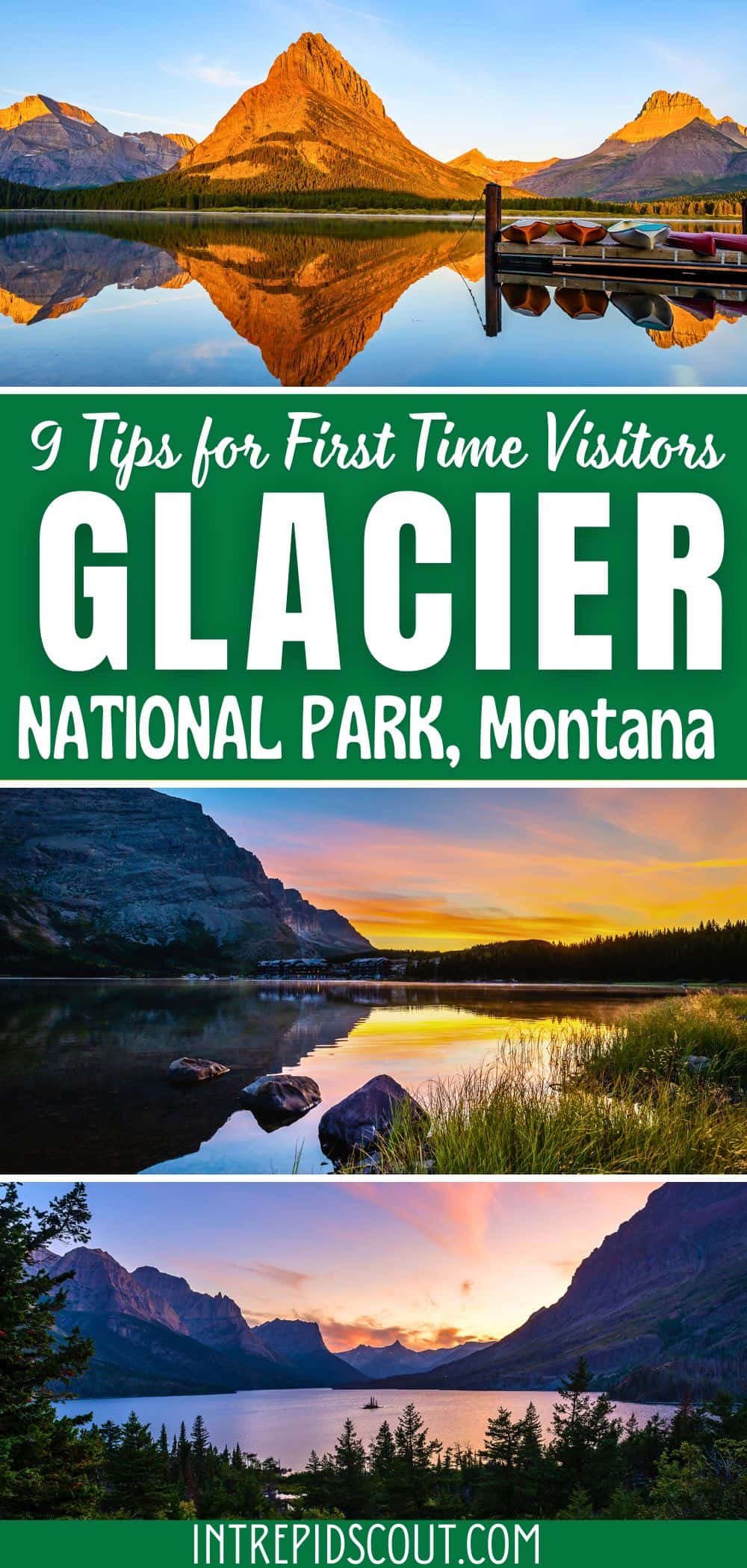
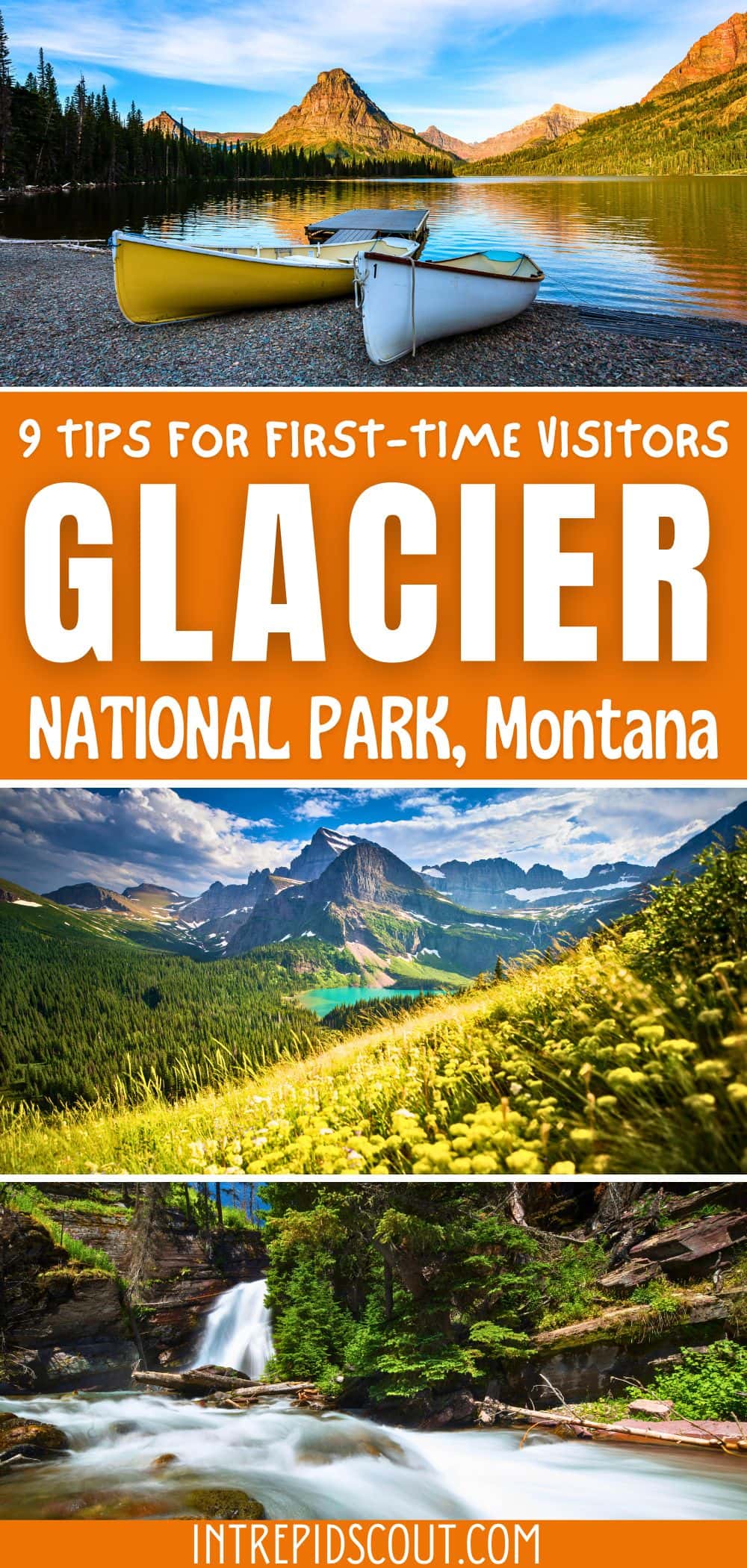
Now, It Is Your Turn, I Would Like to Hear Back from You!
Are you planning your trip to Glacier National Park?
Please let me know! Drop me a quick comment right below!
Click on any of the images below to get inspired and to help you with the planning process for your trip to Glacier National Park!
